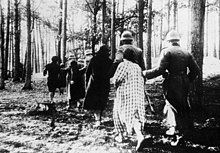Memorial in Palmiry
The Polish memorial in Palmiry was laid out in 1948. It is located in a wooded area near the village of Palmiry (rural municipality of Czosnów ) within the Kampinos National Park in the Masovian Voivodeship . During the German occupation of Poland from 1939 to 1943, secret mass shootings of the Polish civilian population were carried out here by the Gestapo and SS units . The memorial is located near the former mass graves .
history
Before the Second World War there were ammunition depots at this point, which is why the area was called powder keg (Polish: "Po wybuchu") by the local population . These camps, which originally belonged to the Modlin fortress , had supplied the Polish defense troops with ammunition during the siege of Warsaw in September 1939. The ammunition store was provided with a railway connection. In the first months of the occupation, the system including the tracks was dismantled by German units. The surrounding forest was cleared. A clearing was created that was to become a secret place of execution. Shootings were carried out here for the first time on December 14, 1939.
The executions in Palmiry were carefully planned by the Gestapo deployed in Warsaw. A few days before the transport, a department of the Reich Labor Service billeted in nearby Łomna , and sometimes Hitler Youth units camping near Palmiry, dug pits suitable for mass graves in the clearing. These pits were about 2.5 m deep and 30 m long. To be shot victims were mostly from the Warsaw Pawiak rare from the -Gefängnis, mokotów prison in Rakowiecka brought -Straße onto trucks by Palmiry. Most of the Poles murdered here belonged to the Polish Inteligencja . The height of the shootings was reached in the context of the Poland-wide AB actions .
The prisoners were allowed to take their personal effects with them - on the one hand they were calmed down, on the other hand these items helped with the later identification. After arriving at the place of execution, they had to stand in front of the pits and were shot with machine guns. The filled pits were planted with pine trees. Despite extensive cordoning off of the site and the highest level of secrecy, the Polish underground movement had been aware of the massacres taking place near Palmiry since the winter of 1939. Especially Polish forest workers were able to document the events and mark the mass graves. Trees were marked at night under the forester Adam Herbański, with the help of which the graves could later be found.
From November 25, 1945 to the autumn of 1946, the Polish Red Cross carried out the exhumation of the bodies in the presence of representatives of the Main Commission for the Investigation of Nazi Crimes in Poland . 24 mass graves were found over an area of 1.5 km². The exact total number of victims shot and buried at Palmiry is not known. Depending on the sources, there were between 2,115 (exhumed) and 2,255 people, many of them of Jewish descent. About 20% were women. Among the here murdered the Olympic medalists were Janusz Kusociński and Tomasz Stankiewicz , the chess champion Dawid Przepiórka , university professors Stefan Kopeć and Kazimierz Zakrzewski , politicians Henryk Brun , Helena Jaroszewicz , Mieczysław Niedzialkowski , Stanisław Piasecki , Maciej Rataj ( Sejm ) and the mayor Mikołaj Bożym , Adolf Kutkowski , Mieczysław Markowski and Jan Pohoski .
Memorial today
The exhumed corpses were buried in a newly laid out cemetery near the mass graves. This cemetery is now the centerpiece of the Palmiry memorial, which has existed since 1948. In 1973 the Museum of Struggle and Martyrdom (Polish: "Muzeum Walki i Męczeństwa") was opened here, in which documents and artefacts from the exhumation and the activities of the Polish underground movement in the area are exhibited. Since 1980 this museum has belonged to the Warsaw Museum . On July 9, 2004, a storm caused considerable tree damage to the entire complex, which could not be finally repaired until spring 2005 by soldiers of the Warsaw garrison. In 2009, a competition was announced for a new construction of the museum building.
The German Chancellor Gerhard Schröder visited the memorial during his visit to Warsaw in 1999 and laid a wreath here.
In the United States Holocaust Memorial Museum in Washington, DC a tree stump from Palmiry was used as a design element.
Individual evidence
- ^ Adam Krzemiński : The knee fall . In: in: Étienne François ; Hagen Schulze (ed.): German places of remembrance , paperback special edition, volume 1, CH Beck, Munich 2003, ISBN 3-406-50987-8 , p. 641.
- ^ A b Tadeusz Piotrowski: Poland's Holocaust. Ethnic strife, collaboration with occupying forces and genocide in the Second Republic. 1918-1947 , McFarland & Co, Jefferson 1998, ISBN 978-0-7864-2913-4 , p. 24 (in English).
- ↑ Jerzy S. Majewski: Palmiry - nowy obiekt w miejscu zbrodni ( page no longer available , search in web archives ) Info: The link was automatically marked as defective. Please check the link according to the instructions and then remove this notice. . In: " Gazeta Wyborcza ", July 11, 2009 (in Polish).
- ↑ Ulrich Deupmann: Free movement of workers in the Union only after a transition period: Schröder supports Poland's desire to join the EU. In: berliner-zeitung.de. September 4, 1999, accessed October 16, 2018 .
- ↑ Where does it end? . In: New York Magazine , May 10, 1993.
literature
- Władysław Bartoszewski : The ring of death around Warsaw, 1939–1944 , Interpress, Warszawa 1969, pp. 38–85.
Web links
- Museum website (in Polish and English)
- Palmiry: Cemetery-mausoleum at Szetl.org (in English)
Coordinates: 52 ° 20 ′ 2 ″ N , 20 ° 44 ′ 41 ″ E



